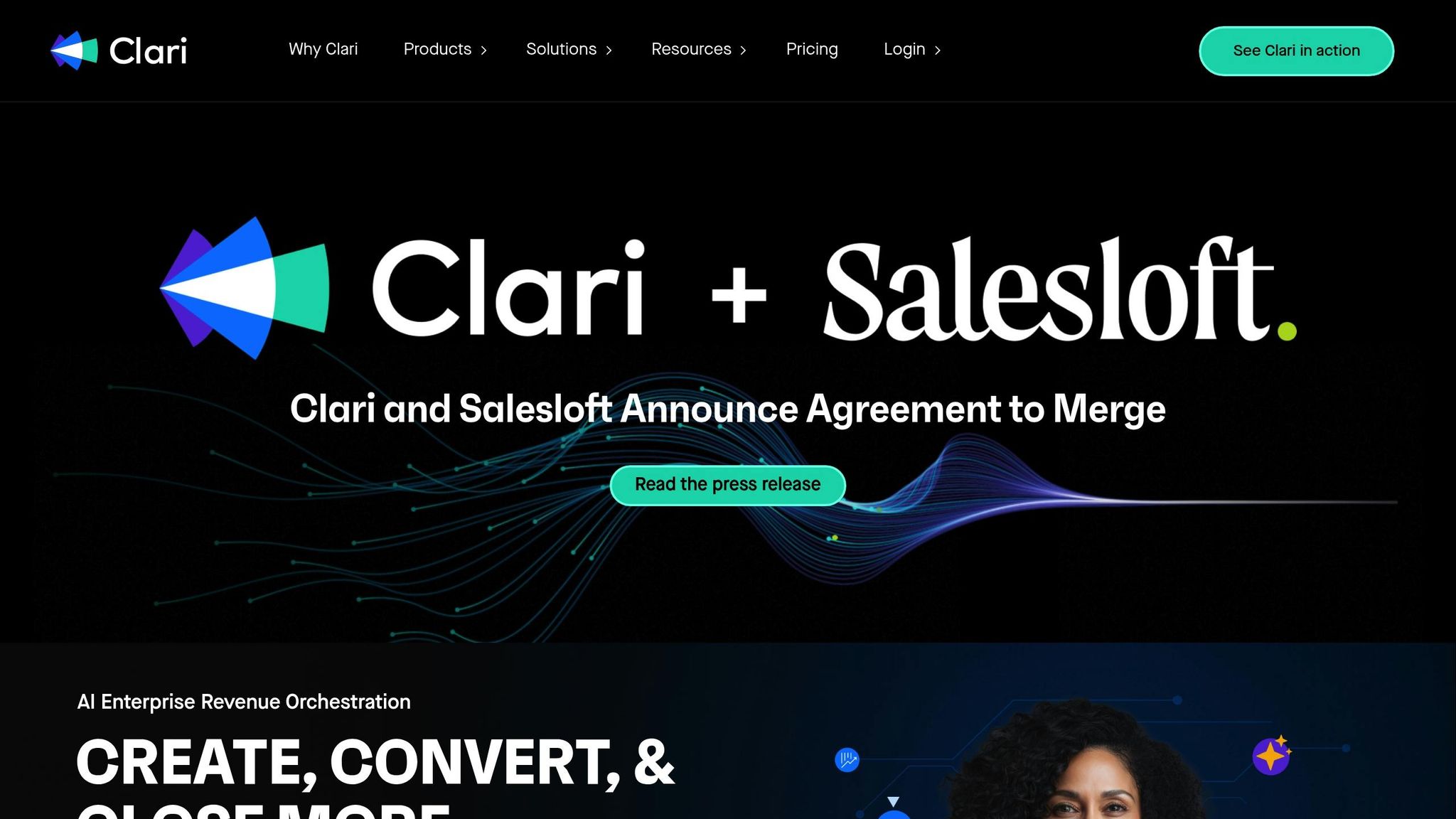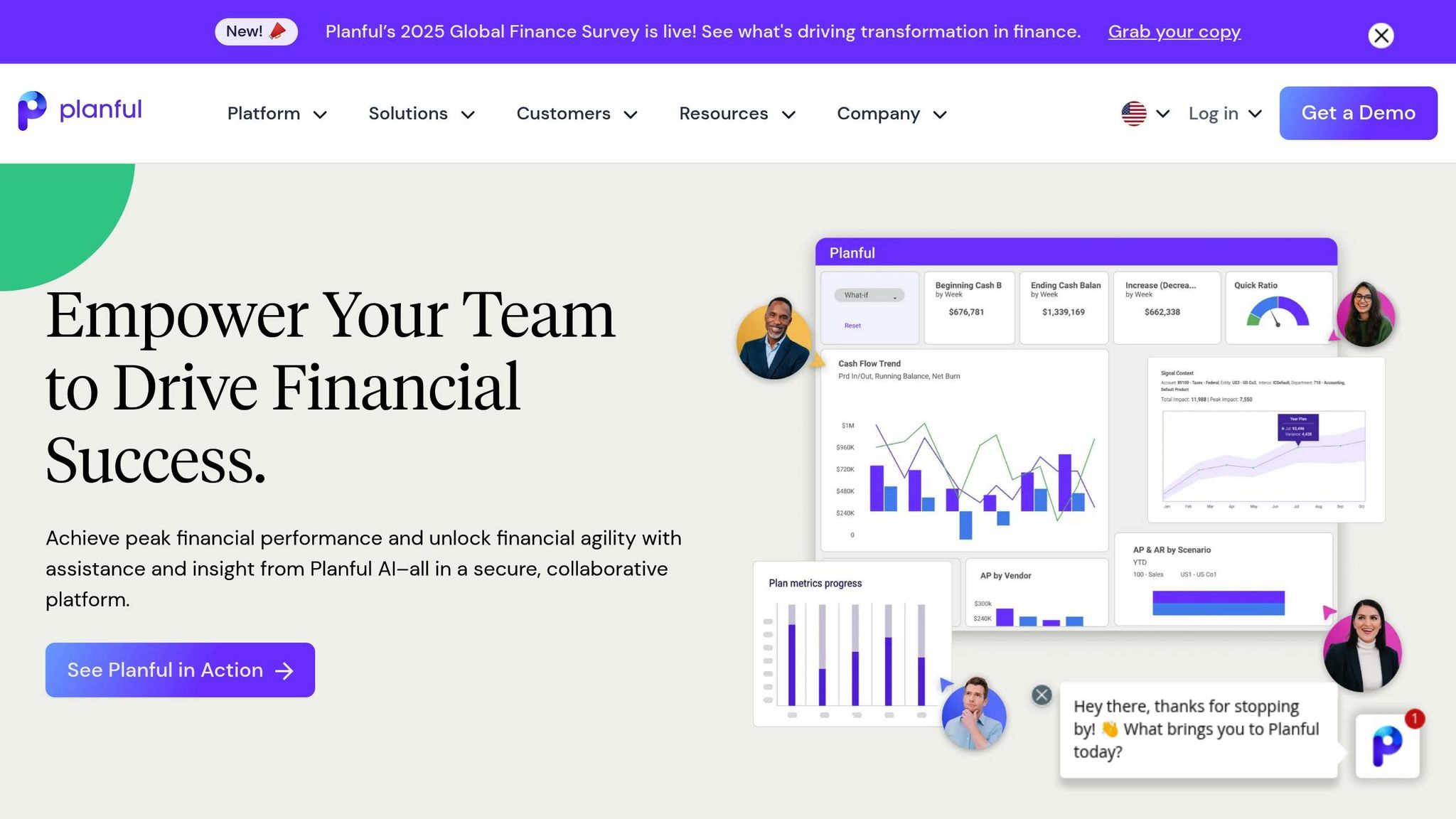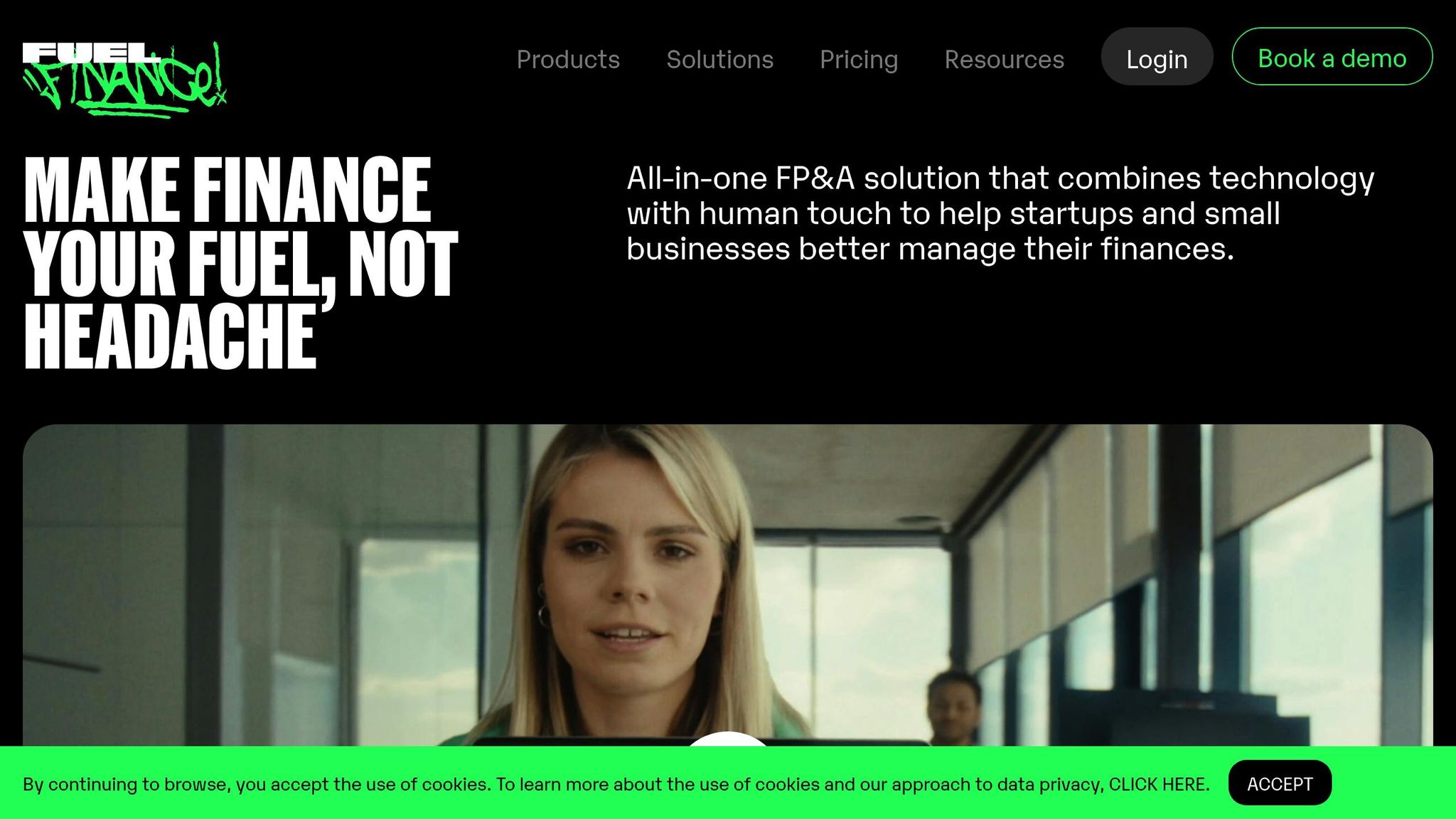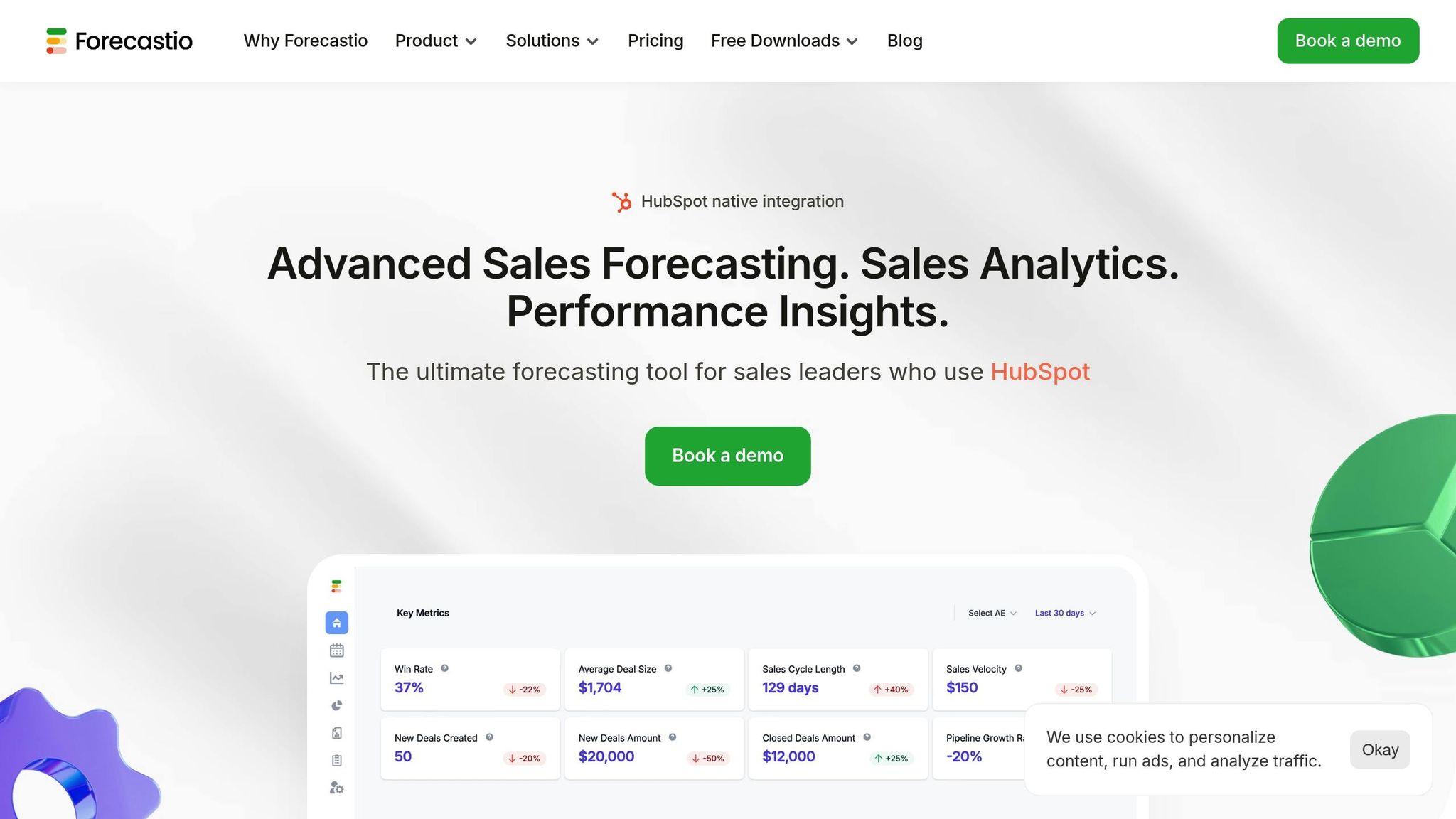Predicting industry growth is essential for businesses and investors looking to make informed decisions. Modern platforms simplify this process by using advanced algorithms, AI, and data visualization tools. Here's a quick summary of six platforms that stand out:
- Clari Revenue Platform: Focuses on sales and revenue forecasting with 98% accuracy and AI-driven insights.
- Planful: Offers dynamic financial planning and rolling forecasts with strong integration capabilities.
- Fuelfinance: Centralizes financial data for better predictions and user-friendly functionality.
- Forecastio: Machine learning-first tool with real-time updates and scenario modeling.
- Vena Solutions: Combines Excel familiarity with collaborative cloud features for finance teams.
- Cube: Bridges Excel workflows with cloud analytics for streamlined forecasting.
Each platform caters to different needs, from sales-focused tools to comprehensive financial planning systems. Below, we’ll dive deeper into their features, strengths, and pricing.
Quick Comparison
| Platform | Key Feature | Best For | Starting Price (USD) |
|---|---|---|---|
| Clari Revenue Platform | Revenue-focused AI insights | Sales-driven companies | Custom Pricing |
| Planful | Rolling forecasts, ERP integration | Financial planning | Custom Pricing |
| Fuelfinance | Centralized financial data | Small businesses | Custom Pricing |
| Forecastio | Real-time machine learning | Fast-paced industries | $99/month |
| Vena Solutions | Excel-based collaboration | Finance teams | Custom Pricing |
| Cube | Cloud-linked Excel workflows | Mid to large businesses | $1,200/month |
These tools simplify forecasting, reduce risks, and offer insights tailored to different industries. Read on for a detailed breakdown of their features and pricing.
What Software Is Used For Financial Forecasting? - BusinessGuide360.com
1. Clari Revenue Platform

Clari Revenue Platform is a powerhouse in revenue management, trusted by over 1,500 customers worldwide to oversee more than $5 trillion in revenue annually. Designed for enterprise-level performance, it has earned recognition for its precise forecasting capabilities, helping businesses confidently navigate intricate growth challenges.
Forecast Accuracy
Clari's forecasting tool delivers an impressive 98% accuracy by the second week of each quarter. This level of precision significantly reduces the guesswork and uncertainties that often plague traditional forecasting methods. By analyzing vast amounts of revenue data, the platform uncovers patterns that manual methods might miss, enabling companies to identify emerging opportunities early. With its robust forecasting foundation, Clari's advanced AI takes revenue insights to the next level.
AI Capabilities
At the core of Clari’s technology is its proprietary "Revenue Context™" system, which integrates data from every signal, cadence, and workflow to streamline revenue processes. By combining predictive and generative AI, the platform enhances operational efficiency and drives growth. It analyzes historical sales data and customer behavior to pinpoint prospects most likely to convert. The results speak volumes: Clari customers have seen new logo deals close 20% faster compared to two years ago, and the use of AI Deal Summaries has skyrocketed by 572% in just six months. This seamless AI integration ensures smarter and faster decision-making across revenue operations.
Data Integration
One of Clari's standout features is its ability to consolidate data from multiple revenue sources into a single, unified view. AI is embedded throughout the platform, powering essential workflows like sales forecasting, pipeline management, and CRM automation. This integration simplifies complex processes, allowing businesses to adapt to market changes in real time and make precise, data-driven decisions.
Visualization Features
Clari transforms intricate revenue data into easy-to-understand dashboards, making it simple to spot growth trends and market shifts. These visualization tools help users track evolving consumer preferences, identify potential risks, and respond proactively to market changes. The platform also personalizes insights by segmenting customers and analyzing historical trends to refine sales strategies. This segmentation extends to industry analysis, offering visual insights into growth patterns across regions and sectors, ensuring businesses stay ahead of the curve.
2. Planful

Planful takes a different approach from Clari by focusing on comprehensive financial planning. It transforms traditional spreadsheet-based forecasting into a collaborative, dynamic process that helps businesses make smarter strategic decisions.
Forecast Accuracy
Planful’s forecasting engine uses statistical modeling and machine learning to predict a range of business scenarios. Its rolling forecasts update projections in real time, offering greater precision compared to static annual budgets. By combining external market data with internal metrics, it provides a more complete picture of industry trends.
AI Capabilities
AI plays a key role in Planful’s forecasting tools. Features like automated variance analysis, predictive modeling, and natural language processing help identify anomalies and deliver actionable insights. Natural language processing, in particular, ensures that even complex data insights are easy for all stakeholders to understand.
Data Integration
Planful simplifies data management by integrating with ERP, CRM, and data warehouse systems through APIs and pre-built connectors. It enables real-time data synchronization across multiple applications, so finance teams can spend less time consolidating data and more time on strategic planning.
Visualization Features
The platform excels at turning complex data into interactive dashboards and reports that highlight growth trends and key performance indicators. With tools like customizable charts, graphs, and heat maps, users can create visuals that make insights easier to grasp. The drag-and-drop report builder is especially handy for creating executive-level presentations that communicate recommendations clearly and effectively.
Pricing
Planful offers flexible subscription options. For specific pricing details, you’ll need to contact the company directly.
3. Fuelfinance

Fuelfinance stands out for its ability to bring together financial data from various sources, creating a centralized hub for generating predictive insights. Here's how it works:
Data Integration
Fuelfinance simplifies the process of combining financial and accounting data from multiple external systems into one cohesive platform. By doing so, it allows businesses to create forecasts based on comprehensive, interconnected data rather than isolated pieces. The platform integrates effortlessly with a wide range of third-party tools, including ERP systems, accounting software, CRM platforms, and business intelligence tools. This ensures that forecasting models always have access to real-time, organization-wide data. Moreover, Fuelfinance prioritizes security, ensuring that data imports and consolidations are handled safely.
Forecast Accuracy
Thanks to its robust data integration, Fuelfinance's predictive models are better equipped to identify trends and patterns that might otherwise go unnoticed in fragmented datasets. This comprehensive approach improves the reliability of forecasts by offering a more complete view of a business's performance.
4. Forecastio

Forecastio takes a machine learning-first approach to forecasting industry growth, offering businesses a platform that learns from historical data to predict future trends. Its goal? To make advanced forecasting tools accessible, even for those without a background in data science.
AI Capabilities
At the heart of Forecastio is its ensemble machine learning system, which automatically adjusts to changes in the market. Instead of relying on a single algorithm, Forecastio combines multiple models, weighing their outputs based on past performance to improve prediction accuracy.
Another standout feature is its ability to retrain algorithms automatically. As new data flows in, the platform refines its forecasts, ensuring predictions become more precise over time - without any manual input from users.
Forecastio also includes anomaly detection to identify unusual patterns in the data. If unexpected trends or outliers emerge, the system alerts users and explains how these anomalies could influence future forecasts. This adaptability is further supported by its seamless data integration capabilities.
Data Integration
Forecastio connects to over 200 data sources, including popular tools like Salesforce, HubSpot, QuickBooks, and Google Analytics. Using API connections, it pulls data automatically, eliminating the hassle of manual uploads or importing CSV files.
The platform supports real-time data synchronization, updating forecasts as new information comes in. This is especially useful for businesses monitoring fast-changing metrics like website traffic, sales, or inventory levels.
For companies with unique data needs, Forecastio offers flexible integration options such as webhook support and custom API endpoints. It also integrates with data warehouses like Snowflake and Amazon Redshift, making it adaptable to a wide range of data environments.
Visualization Features
Forecastio excels in presenting data through interactive dashboards that let users explore specific time frames or data segments. These visualizations include confidence intervals, illustrating a range of possible outcomes rather than single-point predictions.
The platform also features scenario modeling tools. Users can tweak key variables - like adjusting prices or marketing spend - and instantly see how these changes might impact future outcomes. For instance, a retailer could simulate how a 15% price increase might affect sales over the next six months.
Forecastio’s responsive charts work seamlessly across devices, and users can share visualizations via secure links or embed them in presentations and reports, making collaboration effortless.
Pricing (USD)
Forecastio offers tiered subscription plans based on the number of data sources and forecast frequency:
- Starter Plan: $99/month for up to 5 data sources and daily forecasts
- Professional Plan: $299/month for up to 25 data sources and hourly forecasts
- Enterprise Plan: $799/month for unlimited data sources and real-time forecasts
All plans include unlimited user access and a 14-day free trial. Customers opting for annual subscriptions receive a 20% discount, and custom pricing is available for organizations with specialized needs or requiring dedicated support.
sbb-itb-2e26d5a
5. Vena Solutions
Vena Solutions is a financial planning platform tailored for finance teams aiming to improve forecasting. It seamlessly combines the familiar interface of spreadsheets with the power of cloud collaboration, making it easier to refine and enhance financial predictions.
Forecast Accuracy
By integrating with Excel and using advanced statistical tools, Vena Solutions helps identify trends and seasonal patterns. Users can input custom assumptions, while built-in variance analysis ensures forecasts are fine-tuned and reliable.
Data Integration
The platform simplifies data consolidation by connecting directly to enterprise systems through pre-built connectors. Automated data validation ensures all information is accurate and complete before being used in forecasts. With real-time updates, scheduled processing, and data lineage tracking, users can trust their models to deliver consistent and dependable results.
Visualization Features
Vena Solutions offers interactive dashboards that retain the familiar Excel look but add dynamic charting and reporting capabilities. Teams can collaborate on forecasts simultaneously, with tools for version control, approvals, and audit trails. The platform also supports exploring what-if scenarios and creating polished financial reports ready for management review. These features are paired with a flexible pricing structure to suit different business needs.
Pricing
Vena Solutions operates on a subscription basis, with pricing that adjusts based on the number of users and the complexity of features required. This makes it suitable for businesses with varying analytics needs.
6. Cube
Cube bridges the gap between traditional Excel workflows and modern cloud-based analytics, making it simpler for finance teams to forecast while sticking to the familiarity of spreadsheets.
Forecast Accuracy
Cube enhances forecast precision by directly linking to core systems and automating data entry. It pulls financial data from platforms like ERP systems, CRMs, and other business tools, ensuring forecasts are always based on the latest and most accurate information. Teams can create and compare multiple scenarios - optimistic, realistic, or conservative - within the same workspace, streamlining decision-making.
The platform's variance analysis tools automatically highlight significant differences between actual outcomes and projections. This helps finance teams spot trends that could influence future forecasts and make timely adjustments. Additionally, real-time updates ensure rolling forecasts evolve with new data, keeping predictions accurate and relevant.
Data Integration
Cube’s robust integrations ensure forecasting models remain current and reliable. It connects seamlessly with popular systems like Salesforce, NetSuite, QuickBooks, and Xero. By using pre-built data mapping, Cube standardizes financial data for consistent analysis. Automated refresh schedules further guarantee that forecasts reflect the latest business performance.
To maintain data quality, Cube employs validation rules to check for missing or inconsistent entries before incorporating them into models. Custom business rules can flag unusual patterns, helping users address potential issues early. Thanks to real-time synchronization, updates in source systems are instantly reflected in forecasts, eliminating manual updates.
Visualization Features
Cube’s interactive dashboards and customizable reporting templates allow teams to collaborate effectively. Team members can track changes, add comments, and document assumptions directly within the platform. This transparency ensures everyone stays aligned.
Users can drill down from high-level summaries to granular line-item details, making it easy to identify the factors driving forecast changes. Built-in approval workflows ensure that all revisions are reviewed and approved before being finalized, adding an extra layer of accountability.
Pricing
Cube’s pricing starts at around $1,200 per month for smaller teams, with costs scaling based on the number of users and data sources. Mid-market packages typically range between $2,500 and $5,000 per month, while enterprise-level implementations can exceed $10,000 monthly.
A free trial is available, giving teams the chance to explore key features before committing to a subscription. Setup fees are separate and depend on the complexity of the required integrations. Most organizations can expect implementation costs to fall between $5,000 and $15,000 for standard setups.
Platform Advantages and Disadvantages
Every platform comes with its own set of strengths and challenges. To choose the right one, it’s essential to align your organization’s needs and resources with what each platform offers.
Here’s a breakdown of what you can expect from some of the top platforms:
Clari Revenue Platform focuses on sales-driven forecasting, leveraging historical sales data and current opportunities to predict revenue. While its specialization in revenue forecasting is a strong suit, it may not be ideal for organizations that require broader financial planning tools. Additionally, its pricing might be a hurdle for smaller teams working with limited budgets.
Planful delivers a robust suite for financial planning and budgeting, offering tools like scenario modeling and variance analysis. It also integrates seamlessly with ERP systems. That said, the initial setup can be complex, which may require additional training - something that could strain teams with fewer resources.
Fuelfinance stands out for its user-friendly interface, making it approachable even for those without extensive forecasting experience. Features like drag-and-drop functionality simplify training and onboarding. However, businesses with more intricate forecasting requirements might find its analytical tools lacking.
Forecastio shines in fast-paced environments, thanks to its automation capabilities and real-time data synchronization. Its API integrations further enhance data connectivity. On the downside, its reporting and visualization customization options are somewhat limited.
Vena Solutions blends the familiarity of Excel with cloud-based analytics, offering features like data validation and audit trails to ensure accuracy and compliance. However, its reliance on Excel can lead to performance issues when handling large datasets.
Cube also integrates Excel workflows with cloud analytics and real-time updates. While this approach appeals to teams already comfortable with Excel, it may struggle to scale for organizations with more complex data requirements.
When deciding among these platforms, organizations should consider their specific forecasting needs, the level of integration required, and their team’s expertise. Balancing cost, functionality, and ease of use will help ensure the right choice for supporting growth in the forecasting space.
Conclusion
When selecting a forecasting platform, it's crucial to align your choice with your organization's specific needs. For small and medium businesses, user-friendly options like Fuelfinance can be a great fit. On the other hand, larger companies may find comprehensive solutions such as Planful or Clari Revenue Platform better suited to their demands. Your industry focus should also play a significant role in the decision-making process.
For example, sales-driven companies might benefit from Clari's revenue-focused features, while organizations requiring more extensive financial planning tools may lean toward Planful. If your business operates in a fast-paced environment, tools like Forecastio, with its real-time updates and automation, could be a game-changer.
Don't overlook data integration needs. If your team relies heavily on Excel workflows, platforms like Vena Solutions or Cube could be ideal. For businesses managing large datasets, scalability becomes a critical factor to consider.
Budget is another key consideration. While feature-rich platforms like Planful offer advanced capabilities, their cost may be prohibitive for some. Make sure to weigh the features you truly need against your available resources.
Forecasting tools are constantly evolving, so it’s worth exploring resources like the Best Investing Tools Directory for up-to-date reviews and comparisons to guide your decision.
Ultimately, choose a platform that matches your team’s expertise, integrates seamlessly with your existing systems, and supports your business as it grows. The right tool will help you achieve greater accuracy and efficiency in your forecasting efforts.
FAQs
What’s the best way to choose a forecasting platform for my business?
Choosing the best forecasting platform for your business starts with understanding what you truly need. Think about the type of data you’ll be handling, the specific demands of your industry, and how comfortable your team is with technical tools.
Focus on platforms that prioritize user-friendliness, adaptability, and growth potential. It’s also worth checking if the platform can integrate smoothly with your current tools and systems - this can make a huge difference in efficiency. Look for features that cater to your industry, such as specialized forecasting models or advanced analytics.
By matching the platform’s capabilities to your business objectives, you’ll set yourself up for a smarter, more effective choice.
How do the featured forecasting platforms differ in their data integration capabilities?
Forecasting platforms stand apart mainly in how they manage data integration. The key aspects to consider are their ability to automate data imports through APIs, enable real-time updates, and effortlessly link with a variety of data sources.
Platforms with strong integration features minimize the need for manual data entry, keeping forecasts precise and current. This not only streamlines the process but also boosts the dependability of the insights they provide.
How does AI improve the accuracy and speed of forecasting industry growth on these platforms?
AI plays a key role in improving how industries predict growth. By processing massive datasets at incredible speed, it uncovers patterns that might otherwise go unnoticed, while also cutting down on errors. This leads to faster, more accurate insights that businesses can act on.
Through automation of complex tasks, AI gives companies the tools they need to make smarter strategic decisions. It also helps them stay ahead of market trends, making adjustments with greater confidence and efficiency.



